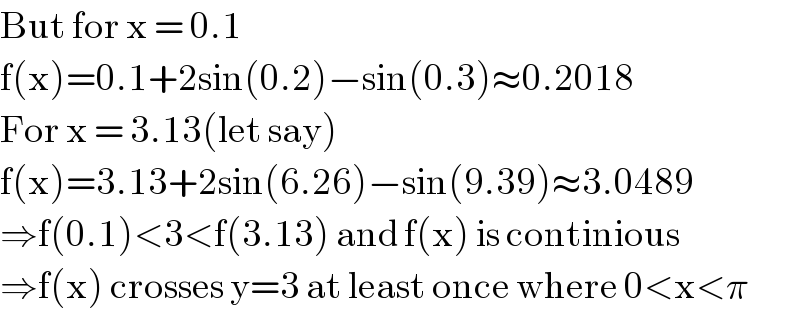
Question Number 17815 by Tinkutara last updated on 11/Jul/17

$$\mathrm{For}\:{x}\:\in\:\left(\mathrm{0},\:\pi\right),\:\mathrm{the}\:\mathrm{equation} \\ $$$$\mathrm{sin}\:{x}\:+\:\mathrm{2}\:\mathrm{sin}\:\mathrm{2}{x}\:−\:\mathrm{sin}\:\mathrm{3}{x}\:=\:\mathrm{3}\:\mathrm{has} \\ $$$$\left(\mathrm{1}\right)\:\mathrm{Infinitely}\:\mathrm{many}\:\mathrm{solutions} \\ $$$$\left(\mathrm{2}\right)\:\mathrm{Three}\:\mathrm{solutions} \\ $$$$\left(\mathrm{3}\right)\:\mathrm{One}\:\mathrm{solution} \\ $$$$\left(\mathrm{4}\right)\:\mathrm{No}\:\mathrm{solution} \\ $$
Commented by alex041103 last updated on 11/Jul/17

Commented by alex041103 last updated on 11/Jul/17

$$\mathrm{Clearly}\:\mathrm{there}\:\mathrm{are}\:\mathrm{three}\:\mathrm{solutions} \\ $$$$\mathrm{x}\approx\mathrm{1}.\mathrm{2094}\:\mathrm{and}\:\mathrm{f}\left(\mathrm{x}\right)\approx\mathrm{3} \\ $$$$\mathrm{x}\approx\mathrm{1}.\mathrm{3407}\:\mathrm{and}\:\mathrm{f}\left(\mathrm{x}\right)\approx\mathrm{3} \\ $$$$\mathrm{x}\approx\mathrm{3}.\mathrm{1239}\:\mathrm{and}\:\mathrm{f}\left(\mathrm{x}\right)\approx\mathrm{3} \\ $$$$ \\ $$
Commented by alex041103 last updated on 11/Jul/17

$$\mathrm{But}\:\mathrm{for}\:\mathrm{x}\:=\:\mathrm{0}.\mathrm{1} \\ $$$$\mathrm{f}\left(\mathrm{x}\right)=\mathrm{0}.\mathrm{1}+\mathrm{2sin}\left(\mathrm{0}.\mathrm{2}\right)−\mathrm{sin}\left(\mathrm{0}.\mathrm{3}\right)\approx\mathrm{0}.\mathrm{2018} \\ $$$$\mathrm{For}\:\mathrm{x}\:=\:\mathrm{3}.\mathrm{13}\left(\mathrm{let}\:\mathrm{say}\right) \\ $$$$\mathrm{f}\left(\mathrm{x}\right)=\mathrm{3}.\mathrm{13}+\mathrm{2sin}\left(\mathrm{6}.\mathrm{26}\right)−\mathrm{sin}\left(\mathrm{9}.\mathrm{39}\right)\approx\mathrm{3}.\mathrm{0489} \\ $$$$\Rightarrow\mathrm{f}\left(\mathrm{0}.\mathrm{1}\right)<\mathrm{3}<\mathrm{f}\left(\mathrm{3}.\mathrm{13}\right)\:\mathrm{and}\:\mathrm{f}\left(\mathrm{x}\right)\:\mathrm{is}\:\mathrm{continious} \\ $$$$\Rightarrow\mathrm{f}\left(\mathrm{x}\right)\:\mathrm{crosses}\:\mathrm{y}=\mathrm{3}\:\mathrm{at}\:\mathrm{least}\:\mathrm{once}\:\mathrm{where}\:\mathrm{0}<\mathrm{x}<\pi \\ $$
Commented by alex041103 last updated on 11/Jul/17

$$\mathrm{I}'\mathrm{m}\:\mathrm{so}\:\mathrm{sorry}\:\mathrm{sir}\:\mathrm{for}\:\mathrm{misreading}\:\mathrm{the}\:\mathrm{question} \\ $$
Answered by b.e.h.i.8.3.417@gmail.com last updated on 11/Jul/17

$${x}−\frac{{x}^{\mathrm{3}} }{\mathrm{6}}+\mathrm{2}\left(\mathrm{2}{x}−\frac{\mathrm{8}{x}^{\mathrm{3}} }{\mathrm{6}}\right)−\left(\mathrm{3}{x}−\frac{\mathrm{27}{x}^{\mathrm{3}} }{\mathrm{6}}\right)=\mathrm{3} \\ $$$$\mathrm{2}{x}−\frac{\mathrm{1}+\mathrm{16}−\mathrm{27}}{\mathrm{6}}{x}^{\mathrm{3}} =\mathrm{3}\Rightarrow\mathrm{2}{x}−\frac{\mathrm{5}}{\mathrm{3}}{x}^{\mathrm{3}} =\mathrm{3} \\ $$$$\Rightarrow\mathrm{5}{x}^{\mathrm{3}} −\mathrm{6}{x}+\mathrm{9}=\mathrm{0}\Rightarrow{x}=−\mathrm{1}.\mathrm{54}\notin\left(\mathrm{0},\pi\right) \\ $$$$\Rightarrow\left(\mathrm{4}\right)\:{no}\:{solution}. \\ $$$${note}:{it}\:{is}\:{not}\:{a}\:{perfect}\:{way}\:{for}\:{this}\:{Q}. \\ $$$${but}\:{you}\:{can}\:{use}\:{this}\:{method}\:{for}\:{finding} \\ $$$${number}\:{of}\:{answers}\:{and}\:{limit}\:{of}\:{them}. \\ $$
Commented by b.e.h.i.8.3.417@gmail.com last updated on 11/Jul/17

$${yes}\:{you}\:{are}\:{right}.{i}\:{have}\:{a}\:{mistake}. \\ $$$${the}\:{cubic}\:{eq}.{has}\:{only}\:{this}\:{real}\:{answer}. \\ $$$${that}\:\:{not}\:{lies}\:{in}:\left(\mathrm{0},\pi\right).{so}\:{eq}.{has}\:{not} \\ $$$${any}\:{solution}\:{in}:\left(\mathrm{0},\pi\right)\Rightarrow{answer}\left(\mathrm{4}\right). \\ $$
Commented by alex041103 last updated on 11/Jul/17

$$\mathrm{You}\:\mathrm{are}\:\mathrm{using}\:\mathrm{the}\:\mathrm{first}\:\mathrm{two}\:\mathrm{terms}\:\mathrm{of}\:\mathrm{the}\:\mathrm{taylor} \\ $$$$\mathrm{expansion}\:\mathrm{for}\:\mathrm{sin}\left(\mathrm{x}\right),\:\mathrm{aren}'\mathrm{t}\:\mathrm{you} \\ $$
Commented by b.e.h.i.8.3.417@gmail.com last updated on 11/Jul/17

$${yes}\:,{mr}\:{alex}. \\ $$
